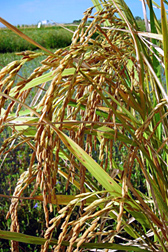This page has been archived and is being provided for reference purposes only. The page is no longer being updated, and therefore, links on the page may be invalid.
| Read the magazine story to find out more. |
|
|
New Rice Varieties Offer Benefits to Growers
By Sharon DurhamOctober 31, 2011
New rice varieties that offer new options for U.S. growers and expanded market opportunities for the U.S. rice industry have been developed by U.S. Department of Agriculture (USDA) scientists and cooperators.
Agricultural Research Service (ARS) scientists at the agency's Dale Bumpers National Rice Research Center (DBNRRC) in Stuttgart, Ark., and the ARS Rice Research Unit in Beaumont, Texas, developed the new varieties in collaboration with researchers at Texas A&M University, the University of Arkansas, Clemson University, and the International Rice Research Institute (IRRI) in the Philippines. Rice quality is an area of interest to breeders, growers and researchers.
ARS is USDA's principal intramural scientific research agency, and this research supports the USDA priority of promoting international food security. Geneticists Anna McClung and J. Neil Rutger (retired) at the ARS center in Stuttgart are among the collaborators involved in developing the new rice varieties.
Rutger helped develop JES, an aromatic, soft-cooking, long-grain rice suited for the market predominantly filled by imports. A jasmine-style rice, JES has higher yields, is 5 inches shorter, and matures a week earlier than Jasmine 85, a variety currently grown for this market.
Charleston Gold, another aromatic rice, was derived from Carolina Gold (an heirloom variety that was the basis for establishing the U.S. rice industry) and genetic material from the Philippines and India. It has excellent yields, disease resistance, and good cooking quality. This cultivar may lend itself to production under organic conditions and will be used by the historically authentic cuisine market in the Carolinas. McClung was involved in the development of Charleston Gold.
Although conventional long-grain varieties are grown on more than 75 percent of the rice acreage in the United States, there is interest in developing cultivars that possess specific qualities required for certain value-added markets.
Read more about this and other cooperative studies between ARS and international research partners in the October 2011 issue of Agricultural Research magazine.

